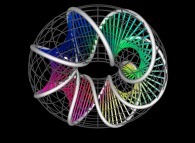Mathematics and Representations
CMAP (Centre de Mathématiques APpliquées) UMR CNRS 7641, École polytechnique, Institut Polytechnique de Paris, CNRS, France
[Site Map, Help and Search [Plan du Site, Aide et Recherche]]
[The Y2K Bug [Le bug de l'an 2000]]
[Real Numbers don't exist in Computers and Floating Point Computations aren't safe. [Les Nombres Réels n'existent pas dans les Ordinateurs et les Calculs Flottants ne sont pas sûrs.]]
[Please, visit A Virtual Machine for Exploring Space-Time and Beyond, the place where you can find more than 10.000 pictures and animations between Art and Science]
(CMAP28 WWW site: this page was created on 02/25/2011 and last updated on 01/04/2025 12:21:35 -CET-)
[en français/in french]
For two thousand years and more from the seventeenth century with Galileo,
Mathematics is seen as the language with which are written the laws of Nature.
They are then, next to the microscope and the telescope,
a revolutionary "instrument of observation" that reveals every day
new and mysterious aspects of our Universe.
These successes only make more mysterious their deep nature and
the cause of their "extremely effectiveness" (Eugene Wigner, prix Nobel de Physique en 1963).
A possible explanation could be that Mathematics is independent of us,
that they exist outside our space-time and that our reality is "just"
a mathematical structure (among countless others...) inside which
emerged autonomous self-conscious sub-structures (we!).
To make progress in our knowledge of the Universe, we must
do Mathematics: juggling with formulas, solving equations,...
All this is generally abstract, but nothing forbids us to use
the sense that evolution has given us and particularly the vision;
our eyes are made to be surprised, and today the computer
allows us a new experimental approach: the virtuality.
A so-called virtual experiment will consist of the in silico
study of a model of a certain system (elementary particles
to the Universe through the car...).
After very heavy computations, raw results are mountains
of numerical values that are a priori useless without further
processing, a "staging".
The translation from numbers to pictures is far to be a childish coloring.
As a matter of fact, many characteristics of the
mathematical "objects" that are manipulated will gang up
to prevent any simple and objective representation.
Thus, they often have no natural images
(properly stupid questions then arise and, for example:
what is the color of the numbers?), the spaces they inhabit
are generally (much...) more than bidimensional, the time
(in the sense of dynamics) is intimately related to space, etc...
Experience in this area shows that it is very easy to hide what
is present and to exhibit what is not, voluntarily or involuntarily...
But Mathematics is also a tool for artistic creation.
The concept of potential work of art emerges: the work of art is no longer
an image or a sound, but simply the underlying mathematical model.
We can be assured that we are not at the end of the road of discoveries, as was
the case in past years with the fractal geometry of Benoît Mandelbrot...
So what scientific and artistic surprises await us, which will
open new horizons to us?
Copyright © Jean-François COLONNA, 2011-2025.
Copyright © CMAP (Centre de Mathématiques APpliquées) UMR CNRS 7641 / École polytechnique, Institut Polytechnique de Paris, 2011-2025.
